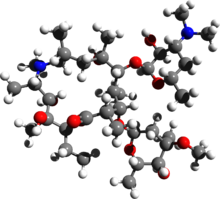
Back أزيثرومايسين Arabic Azitromicina AST آزیترومایسین AZB Азитромицин Bulgarian অ্যাজিথ্রোমাইসিন Bengali/Bangla Azitromicina Catalan Asithromycin Welsh Azithromycin Danish Azithromycin German އެޒިތުރޯމައިސިން DV
 | |
 | |
| Clinical data | |
|---|---|
| Trade names | Zithromax, others[1] |
| Other names | 9-deoxy-9α-aza-9α-methyl-9α-homoerythromycin A |
| AHFS/Drugs.com | Monograph |
| MedlinePlus | a697037 |
| License data |
|
| Pregnancy category |
|
| Routes of administration | By mouth, intravenous, eye drops |
| Drug class | Macrolide antibiotic |
| ATC code | |
| Legal status | |
| Legal status | |
| Pharmacokinetic data | |
| Bioavailability | 38% for 250 mg capsules |
| Metabolism | Liver |
| Elimination half-life | 68 h |
| Excretion | Bile duct[8] |
| Identifiers | |
| |
| CAS Number | |
| PubChem CID | |
| IUPHAR/BPS | |
| DrugBank | |
| ChemSpider | |
| UNII | |
| KEGG | |
| ChEBI | |
| ChEMBL | |
| NIAID ChemDB | |
| CompTox Dashboard (EPA) | |
| ECHA InfoCard | 100.126.551 |
| Chemical and physical data | |
| Formula | C38H72N2O12 |
| Molar mass | 748.996 g·mol−1 |
| 3D model (JSmol) | |
| |
| |
| (verify) | |
Azithromycin, sold under the brand names Zithromax (in oral form) and Azasite (as an eye drop), is an antibiotic medication used for the treatment of several bacterial infections.[10] This includes middle ear infections, strep throat, pneumonia, traveler's diarrhea, and certain other intestinal infections.[10] Along with other medications, it may also be used for malaria.[10] It is administered by mouth, into a vein, or into the eye.[10]
Common side effects include nausea, vomiting, diarrhea and upset stomach.[10] An allergic reaction, such as anaphylaxis, or a type of diarrhea caused by Clostridioides difficile is possible.[10] Azithromycin causes QT prolongation that may cause life-threatening arrhythmias such as torsades de pointes.[11] No harm has been found with its use during pregnancy.[10] Its safety during breastfeeding is not confirmed, but it is likely safe.[12] Azithromycin is an azalide, a type of macrolide antibiotic.[10] It works by decreasing the production of protein, thereby stopping bacterial growth.[10][13]
Azithromycin was discovered in Yugoslavia (present day Croatia) in 1980 by the pharmaceutical company Pliva and approved for medical use in 1988.[14][15] It is on the World Health Organization's List of Essential Medicines.[16] The World Health Organization lists it as an example under "Macrolides and ketolides" in its Critically Important Antimicrobials for Human Medicine (designed to help manage antimicrobial resistance).[17] It is available as a generic medication[18] and is sold under many brand names worldwide.[1] In 2022, it was the 78th most commonly prescribed medication in the United States, with more than 8 million prescriptions.[19][20]
- ^ a b "Azithromycin International Brands". Drugs.com. Archived from the original on 28 February 2017. Retrieved 27 February 2017.
- ^ "Azithromycin Use During Pregnancy". Drugs.com. 2 May 2019. Archived from the original on 18 June 2020. Retrieved 24 December 2019.
- ^ "FDA-sourced list of all drugs with black box warnings (Use Download Full Results and View Query links.)". nctr-crs.fda.gov. FDA. Retrieved 22 October 2023.
- ^ "Zithromax azithromycin 500mg (as dihydrate) tablet blister pack (58797)". Therapeutic Goods Administration (TGA). 12 August 2022. Retrieved 26 April 2024.
- ^ "Zithromax Product information". Health Canada. 16 January 2013. Retrieved 26 April 2024.
- ^ "Drug and medical device highlights 2018: Helping you maintain and improve your health". Health Canada. 14 October 2020. Retrieved 17 April 2024.
- ^ "Zithromax Summary of Product Characteristics (SmPC)". (emc). 5 February 2024. Retrieved 26 April 2024.
- ^ a b Cite error: The named reference
Zithromax FDA labelwas invoked but never defined (see the help page). - ^ "List of nationally authorised medicinal products Active substance: azithromycin (systemic use formulations)" (PDF). European Medicine Agency. 14 January 2021. Archived (PDF) from the original on 18 August 2021. Retrieved 10 March 2023.
- ^ a b c d e f g h i "Azithromycin". The American Society of Health-System Pharmacists. Archived from the original on 5 September 2015. Retrieved 1 August 2015.
- ^ Dunker A, Kolanczyk DM, Maendel CM, Patel AR, Pettit NN (November 2016). "Impact of the FDA Warning for Azithromycin and Risk for QT Prolongation on Utilization at an Academic Medical Center". Hosp Pharm. 51 (10): 830–833. doi:10.1310/hpj5110-830. PMC 5135431. PMID 27928188.
- ^ "Azithromycin use while Breastfeeding". Archived from the original on 5 September 2015. Retrieved 4 September 2015.
- ^ "Azithromycin Stops The Growth of Bacteria" (in German). Archived from the original on 12 May 2020. Retrieved 24 December 2017.
- ^ Greenwood D (2008). Antimicrobial drugs : chronicle of a twentieth century medical triumph (1st ed.). Oxford: Oxford University Press. p. 239. ISBN 978-0-19-953484-5. Archived from the original on 5 March 2016.
- ^ Alapi EM, Fischer J (2006). "Table of Selected Analogue Classes". In Fischer J, Ganellin CR (eds.). Analogue-based Drug Discovery. Weinheim: Wiley-Vch Verlag GmbH & Co. KGaA. p. 498. ISBN 978-3-527-31257-3. Archived from the original on 14 January 2023. Retrieved 2 April 2020.
- ^ World Health Organization (2023). The selection and use of essential medicines 2023: web annex A: World Health Organization model list of essential medicines: 23rd list (2023). Geneva: World Health Organization. hdl:10665/371090. WHO/MHP/HPS/EML/2023.02.
- ^ World Health Organization (2018). Critically important antimicrobials for human medicine (6th revision ed.). Geneva: World Health Organization. hdl:10665/312266. ISBN 978-92-4-151552-8. License: CC BY-NC-SA 3.0 IGO.
- ^ Hamilton R (2015). Tarascon Pocket Pharmacopoeia 2015 Deluxe Lab-Coat Edition. Jones & Bartlett Learning. ISBN 978-1-284-05756-0.
- ^ "The Top 300 of 2022". ClinCalc. Archived from the original on 30 August 2024. Retrieved 30 August 2024.
- ^ "Azithromycin Drug Usage Statistics, United States, 2013 - 2022". ClinCalc. Retrieved 30 August 2024.